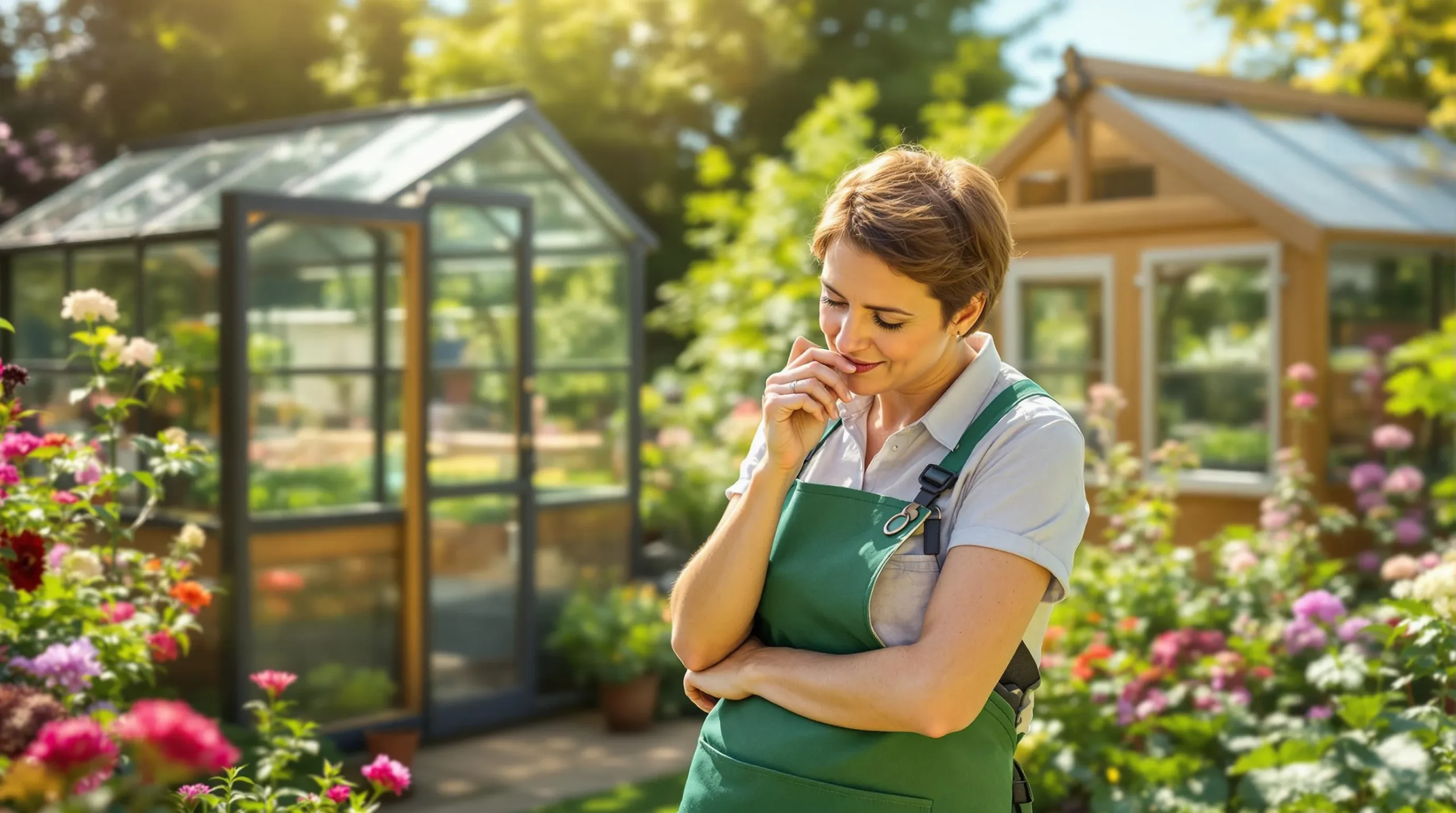
How to Choose Your First Greenhouse: A Complete Beginner’s Guide for 2025
Learn how to choose your perfect first greenhouse with our expert guide. Discover size, materials, and features to extend your growing season by 2-3 months.
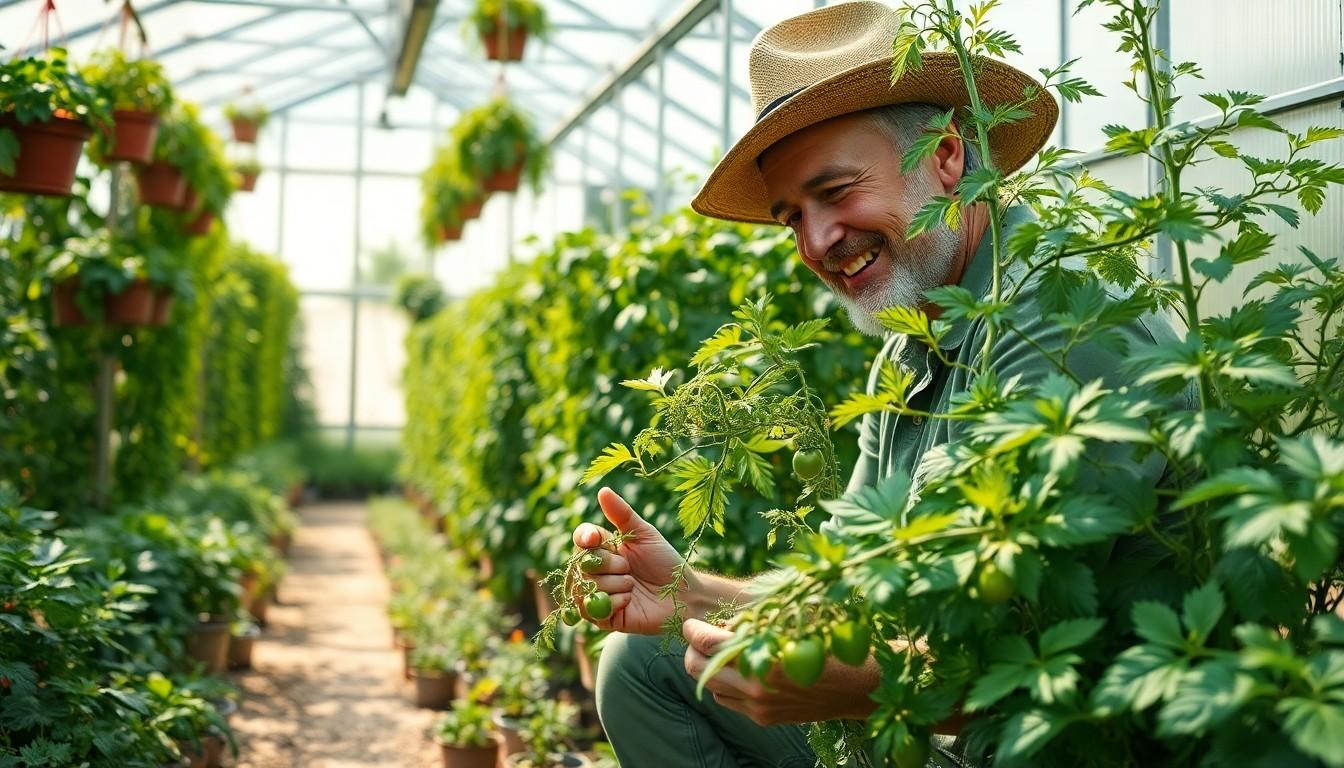
Polycarbonate greenhouse growing is transforming commercial growing, making year-round cultivation more practical than ever before. Their innovative multi-wall design creates insulating air pockets that maintain steady temperatures – essential for maximising crop yields.
These structures deliver benefits beyond temperature control. Their energy efficiency reduces operational costs while creating ideal growing conditions. Polycarbonate panels match glass in light transmission but offer greater durability, creating perfect conditions for temperature-sensitive plants and consistent growth throughout the seasons.
Polycarbonate greenhouses create an optimal growing environment through three primary features. The multiwall construction maintains temperatures 10-15°C warmer than the outside environment. The material provides 85-90% light transmission comparable to glass while diffusing light evenly across plants. The sturdy panels withstand impacts up to 200 times stronger than glass without cracking.
Polycarbonate panels play a crucial role in managing light for plant health. They transmit essential UV rays needed for photosynthesis while reducing hot spots through even light diffusion. This prevents plant scorching during peak sunlight hours and ensures uniform growing conditions across the entire greenhouse.
The multi-wall structure of polycarbonate panels provides excellent heat retention, helping to maintain consistent temperatures throughout day and night cycles. This efficient insulation reduces heating costs by up to 40% compared to single-layer materials. Additionally, the design prevents cold spots near walls and corners, ensuring a balanced climate for all plants.
The greenhouse dimensions affect plant growth capacity and environmental control. A standard commercial setup requires specific measurements for maximum efficiency:
| Dimension | Recommended Range | Purpose |
|---|---|---|
| Height | 3.5-4.5m | Air circulation & heat distribution |
| Width | 6-8m | Plant spacing & access |
| Length | 15-30m | Production scale & workflow |
| Wall thickness | 4-8mm | Insulation & durability |
Structure requirements:
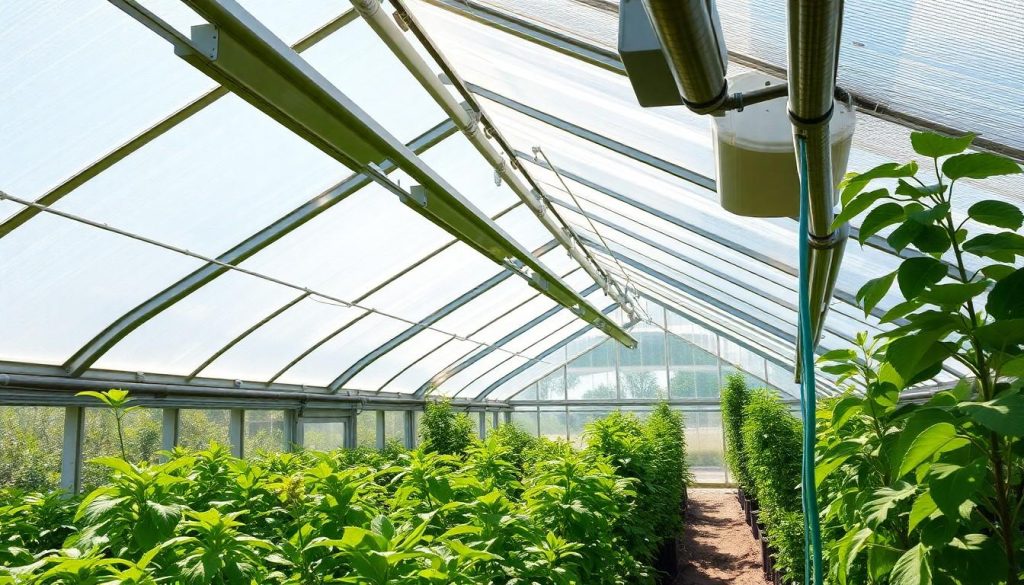
Maximising greenhouse yield depends on establishing the correct foundational elements in your polycarbonate structure.
The positioning of your greenhouse directly impacts plant growth and yield potential. Place the greenhouse in an area with 8-10 hours of direct sunlight daily. Orient the longest side facing south to capture maximum sunlight throughout the growing season. This orientation enables uniform light distribution across growing areas and maintains consistent temperatures.
Good ventilation is key to keeping your greenhouse at the right temperature and humidity levels. It helps prevent overheating and keeps plants healthy by reducing the risk of disease.
Roof vents at the highest points let warm air escape, while side vents along the walls bring in fresh, cooler air. Mechanical fans improve airflow even more, making sure fresh air moves throughout the space.
For an even easier system, automated vents can be linked to temperature sensors, opening and closing as needed. With the right setup, your greenhouse can refresh its air one to two times per hour, creating the perfect growing environment.
A precise irrigation system ensures consistent water delivery to plants. Set up:
The system delivers 2-4 litres of water per square metre daily, depending on plant types and growing conditions.
Environmental monitoring equipment maintains ideal growing conditions:
Position sensors at 3-4 different heights within the greenhouse to create accurate climate zones. Connect these devices to a central control system for automated adjustment of ventilation heaters and irrigation systems.
| Environmental Factor | Optimal Range |
|---|---|
| Temperature | 20-25°C |
| Humidity | 60-70% |
| Light Exposure | 85-90% transmission |
| Air Exchange | 1-2 times per hour |
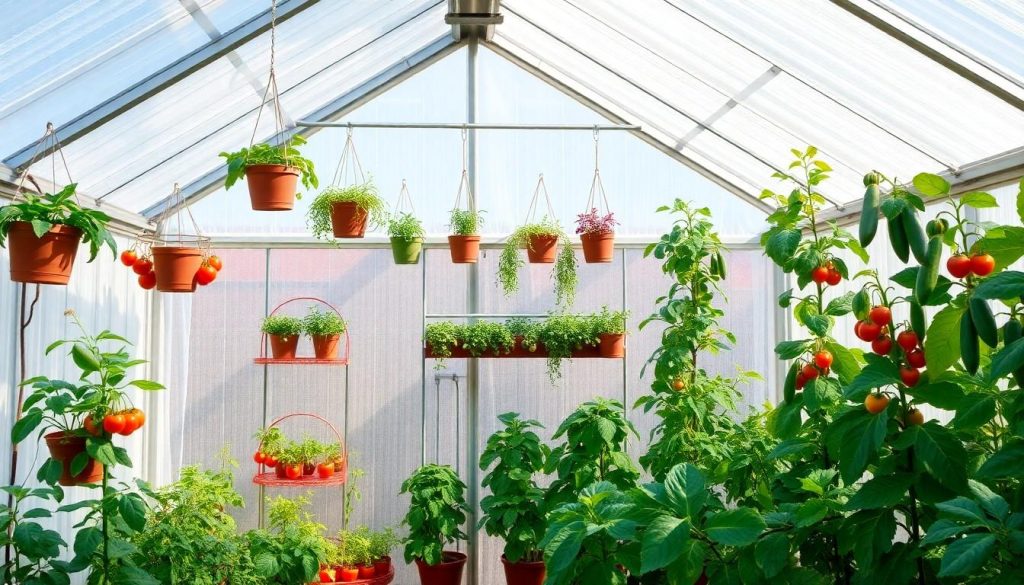
Optimising space in polycarbonate greenhouses increases crop yields through strategic growing methods and efficient space allocation.
| Crop Type | Plant Spacing | Row Spacing |
|---|---|---|
| Tomatoes | 45-50 cm | 150 cm |
| Cucumbers | 40-45 cm | 150 cm |
| Bell Peppers | 35-40 cm | 150 cm |
| Leafy Greens | 20-25 cm | 30 cm |
| Root Vegetables | 10-15 cm | 30 cm |
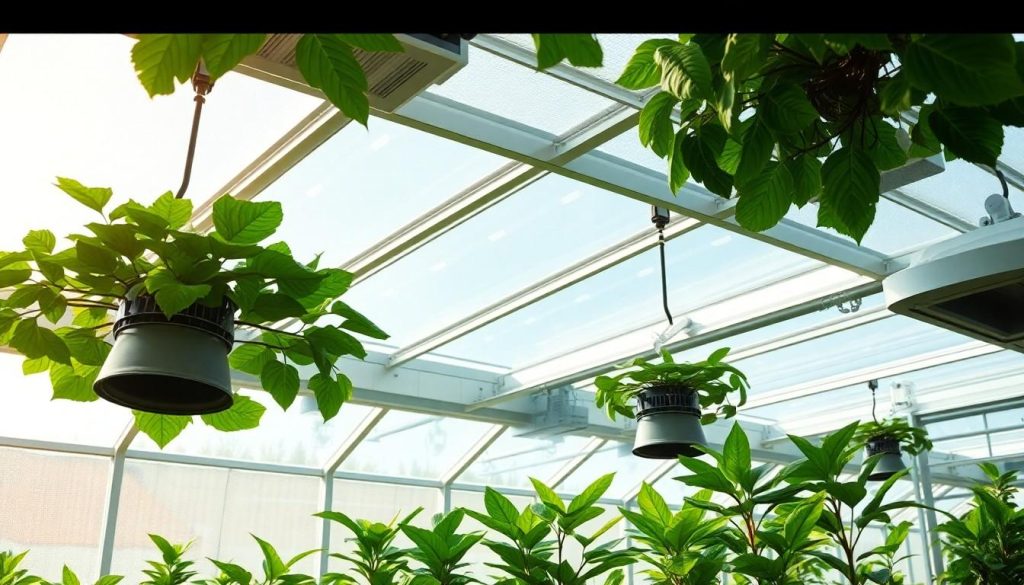
Climate control strategies in polycarbonate greenhouses involve maintaining optimal temperature, humidity, light and air circulation to maximise crop yields and plant health.
Control precise temperatures in polycarbonate greenhouses through radiant heaters and automated ventilation systems. Install thermostats at plant height to monitor temperatures between 18-24°C during the day and 13-18°C at night. Place temperature sensors in multiple zones to identify cold spots or heat pockets.
Key temperature control methods:
Monitor relative humidity levels between 60-80% to prevent disease and optimise plant growth. Position humidity sensors at crop level and connect them to automated controls.
Effective humidity management techniques:
Maximise natural light transmission through clean polycarbonate panels while managing light intensity and duration. The multiwall construction diffuses light evenly across growing areas.
Light control measures:
Create consistent airflow patterns using mechanical ventilation systems. Position fans strategically to eliminate dead air zones and maintain CO2 levels.
Successful crop management in polycarbonate greenhouses relies on three key approaches: seasonal planning, companion planting, and crop rotation.
Map out planting schedules based on optimal growing periods for each crop. Start warm-season crops like tomatoes and peppers in late winter for spring transplanting. Plant cool-season vegetables like lettuce and broccoli in late summer for autumn harvests. Create a detailed calendar marking:
Strategic plant placement enhances growth and pest resistance through beneficial relationships. Carry out these proven combinations:
| Crop Group | Soil Impact | Following Crop |
|---|---|---|
| Leafy Greens | High nitrogen users | Fruit crops |
| Fruit Crops | Heavy feeders | Root vegetables |
| Root Vegetables | Soil structure improvers | Legumes |
| Legumes | Nitrogen fixers | Leafy greens |
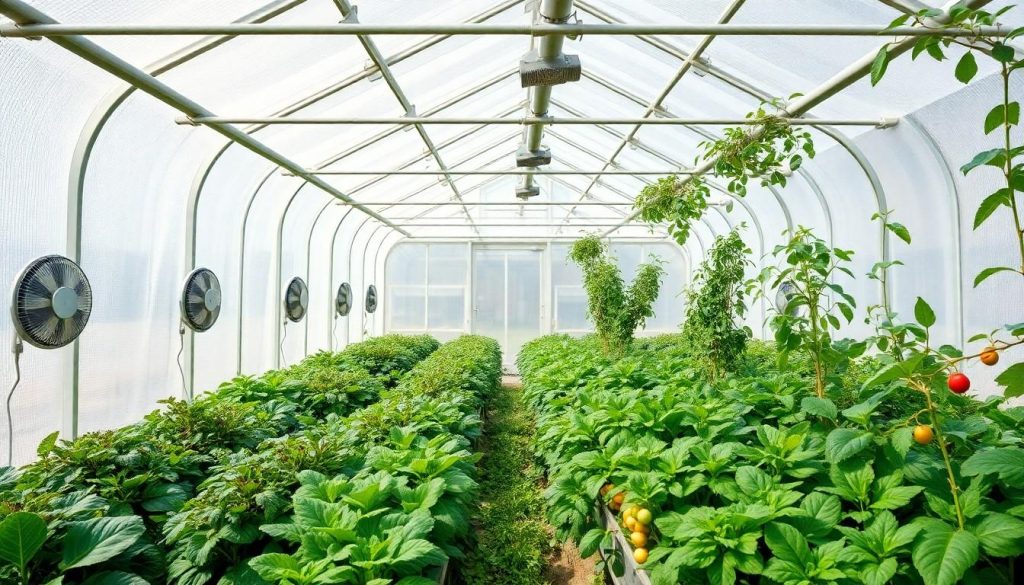
Effective plant care systems in polycarbonate greenhouses create optimal growing conditions for consistent high yields.
Automated irrigation delivers precise water amounts at specific intervals to maintain soil moisture levels. Install drip systems with pressure-compensating emitters to distribute water directly to plant roots. Set up water recycling systems to collect runoff water reducing waste by 40%. Monitor soil moisture using digital sensors placed at 15-20 cm depth to trigger irrigation cycles when readings drop below preset thresholds.
Key components for efficient watering:
Create a nutrition program based on crop growth stages and soil test results. Apply water-soluble fertilisers through the irrigation system in 3-4 weekly cycles. Maintain pH levels between 5.5-6.5 for optimal nutrient uptake.
Base fertilisation rates on crop needs:
Monitor humidity levels to stay below 85% reducing fungal disease risks. Install horizontal airflow fans at 6-metre intervals to prevent moisture accumulation on leaves. Remove infected plants immediately placing them in sealed containers.
Essential prevention measures:
Carry out integrated pest management using sticky traps placed at 3-metre intervals. Release beneficial insects like ladybirds for aphid control and parasitic wasps for caterpillar management. Install fine mesh screens on vents blocking pest entry while maintaining airflow.
Consistent monitoring and prompt problem-solving help safeguard plant health and ensure ideal growing conditions in the greenhouse.
The internal temperature determines plant growth success in polycarbonate greenhouses. Keep temperatures between 80-85°F (26-29°C) during spring and summer for optimal growth.
To control high temperatures:
Proper moisture control prevents disease and promotes healthy plant development.
Key moisture management strategies:
Early detection of plant health issues enables swift intervention and prevents spread.
Common symptoms to monitor:
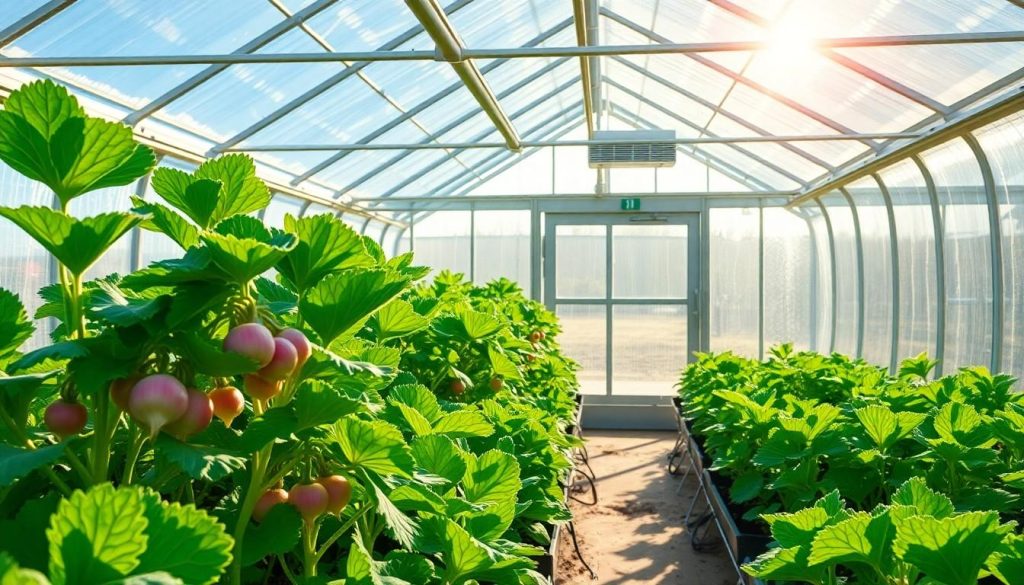
Successful year-round production in polycarbonate greenhouses depends on adapting growing methods for each season while maintaining consistent environmental conditions.
Use radiant heaters and geothermal solutions to maintain temperatures between 18-22°C during cold months. Install insulated walls and roofs to reduce heat loss by up to 40%. Place thermal mass objects like water barrels near plants to store daytime heat and release it at night.
For winter crops:
Control summer temperatures through strategic ventilation and cooling systems. Install evaporative coolers and circulation fans to maintain optimal growing conditions between 20-25°C.
Key summer optimisations:
Prepare greenhouse systems two weeks before each seasonal change. Adjust environmental controls gradually to prevent plant stress during temperature shifts.
Transition checklist:
Effective monitoring systems form the foundation of successful greenhouse management.
Track these essential plant growth indicators to measure greenhouse performance:
Create a digital growth chart to spot trends and identify areas for improvement. Document environmental readings alongside growth data to correlate conditions with plant development.
Measure crop production using these quantifiable metrics:
| Crop Type | Average Yield (kg/m²) | Growing Cycle (days) |
|---|---|---|
| Tomatoes | 40-50 | 60-80 |
| Cucumbers | 30-35 | 45-55 |
| Leafy Greens | 25-30 | 30-40 |
Carry out these data-driven optimisation strategies:
Set specific improvement targets for each growing cycle and maintain detailed records of all changes and their effects on yield.
To maximise your greenhouse’s yield, you need the right setup, good environmental control, and regular maintenance. By using smart growing techniques and keeping a close eye on conditions, you can create the perfect space for your plants to thrive.
Success comes down to the details—maintaining the right temperature, making the best use of space, and adjusting for seasonal changes. A well-managed greenhouse is a productive one, and your commitment to these small but important factors will make all the difference.
With proper planning, regular checks, and quick adjustments when needed, you can enjoy high yields all year round. Keep improving your approach, monitor your results, and let your data guide your decisions for the best possible harvest.
Polycarbonate greenhouses offer superior insulation through multiwall construction, maintaining stable temperatures 10-15°C warmer than outside. They provide excellent light transmission (85-90%), enhanced durability against impacts, and significant energy efficiency, making them ideal for year-round commercial growing and reducing operational costs.
Position the greenhouse to receive 8-10 hours of direct sunlight daily, with its longest side facing south. This orientation ensures uniform light distribution throughout the structure, optimising growing conditions for plants. Proper positioning is crucial for maintaining ideal temperature and maximising crop yields.
Key climate control measures include radiant heaters, automated vent controls, dehumidifiers, and mechanical ventilation systems. Maintain temperatures between 18-22°C, monitor humidity levels, and ensure proper air circulation. Use shade screens in summer and supplemental LED lights during low-light periods.
Implement vertical growing solutions like hanging baskets, wall shelves, trellises, and aquaponic towers. Use multi-level growing systems with tiered shelving units and modular bench systems. Properly space crops according to specific requirements, and incorporate supplemental LED lighting for lower levels.
Employ seasonal planning with detailed sowing and harvesting schedules. Implement companion planting (e.g., basil near tomatoes) to enhance growth and pest resistance. Follow a four-year crop rotation plan to maintain soil health and productivity. Regular monitoring and data collection help optimise growing conditions.
Maintain proper humidity control and sanitation practices. Use integrated pest management strategies, including sticky traps and beneficial insects. Regularly monitor plant health, ensure good air circulation, and implement proper cleaning protocols. Early detection and quick response are crucial for plant protection.
Track essential metrics including plant growth rates, harvest weights, and production cycles. Document successful plant varieties and growing conditions. Use data-driven optimisation by comparing yields, adjusting environmental controls, and testing different nutrient combinations to improve overall productivity.

Learn how to choose your perfect first greenhouse with our expert guide. Discover size, materials, and features to extend your growing season by 2-3 months.
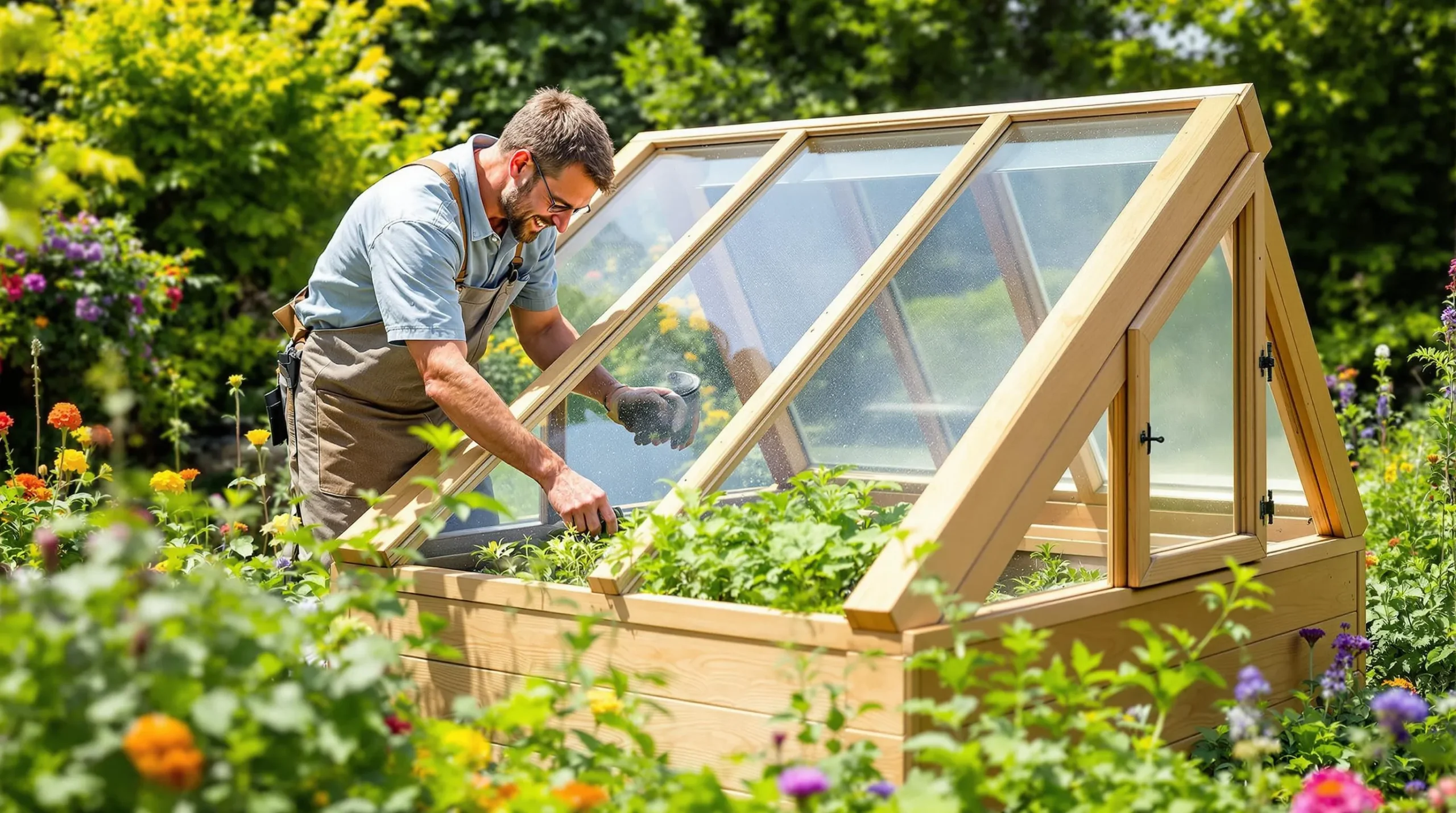
Learn how to make a cold frame to extend your growing season, protect plants in winter, and grow seedlings all year. Simple, cost-effective, and DIY-friendly!